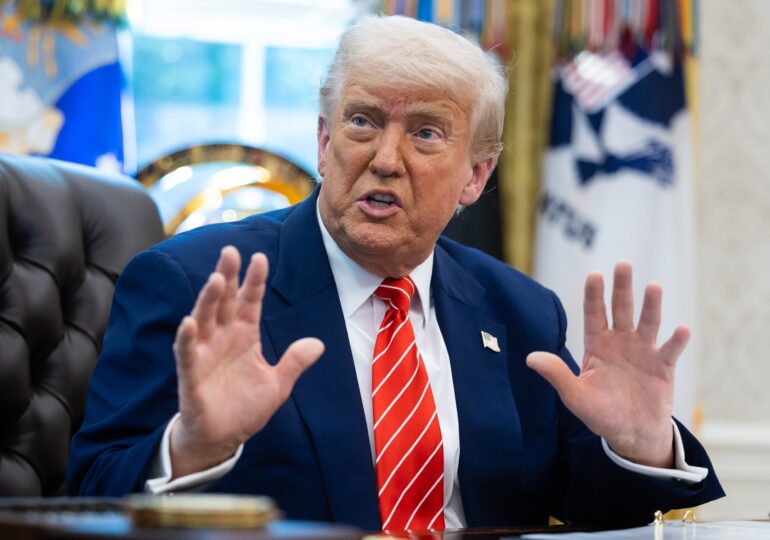The ambitious ‘Golden Dome’ anti-missile shield promoted by American President Donald Trump has raised questions and criticisms regarding its viability, huge budget, and the dangers it poses in terms of space militarization or proliferation encouragement.
It is a defense mechanism for intercontinental missiles, and although it seems to be inspired by Israel’s „Iron Dome,” it is much more sophisticated in terms of scope and conceptual level compared to the Israeli system and other complementary Israeli systems such as „Arrow” and „David’s Sling,” as reported by EFE.
In this respect, it has been defined as a "system of systems" due to the multiple layers it is composed of, including the orbital layer, which uses existing but untested technology.
Some of the satellites in this layer must deploy an interceptor vehicle to collide with the enemy missile and destroy it.
This is complicated because the window for intercepting a projectile in its initial flight phase (the ideal moment for destroying a missile) is 3-5 minutes, and the satellites are constantly in motion, stated Laura Grego, director of the Global Security Department research at the Union of Concerned Scientists (UCS) for EFE.
"To have something in the right place and at the right time, hundreds and hundreds, at least, or rather thousands (of satellites) are needed, even to (intercept) one or two missiles," emphasizes Grego, mentioning that, if a militarily "advanced" state like Russia or China decides to launch ten missiles simultaneously, "that constellation of hundreds or thousands of satellites must be multiplied by ten."
System saturation
In her opinion, this shield "is not a viable way to build defense" because it is "always at a great disadvantage," considering that the enemy can choose to "saturate the system" with a greater number of missiles at any time or "directly attack the system itself" with weapons that disable the satellites.
"Historically, in the field of anti-missile defense, numerous projects have been initiated, spending hundreds of millions and, in some cases, billions of dollars, only to be canceled because they were simply unfeasible," recalls the researcher, referring to programs like President Ronald Reagan's Strategic Defense Initiative (1981-1989), which cost at least $60 billion and was abandoned in 1993.
The expert in nuclear weapons and astrophysics says she does not know why the Trump administration is now interested in such a project, but she is aware that "there is a lot of money to be made" for those involved, including well-known contractors like Lockheed Martin and SpaceX, as well as Silicon Valley startups like Anduril or Palantir.
The massive fiscal and budget package approved this month by Congress and signed by Trump allocates $25 billion for an initial phase of the shield, which the president stated he wants completed by the end of his term in 2029, and which will cost a total of $175 billion. In turn, the Congressional Budget Office estimates that the total cost could be $542 billion over a 20-year period.
All of this makes it the most expensive anti-missile defense system ever approved, and Grego believes that even in the almost total absence of technical information about the "Golden Dome," "if this amount of money has been allocated, something must materialize."
An orbital battlefield
Another criticism, shared by experts like Jeffrey Lewis from the James Martin Center for Nonproliferation Studies, is that a system like the "Golden Dome" could turn space into a battlefield - disregarding the global consensus of the 1967 Outer Space Treaty - as US adversaries could attempt to destroy American satellites.
In this field, it is believed that Russia has long been developing a program to arm satellites with nuclear warheads intended to destroy other satellites, a worrying concept due to the chaotic chain reactions it could generate for the numerous networks of devices orbiting the atmosphere on which critical systems for air and maritime communications and navigation depend.
A shield like the "Golden Dome" - Grego explains - not only provides an incentive to launch an arms race, but also "generates uncertainty" regarding the idea that the US could become too secure behind their shield, and other powers, once the concept of "mutual vulnerability" is destroyed, would lose the ability to deter Washington from attacking first.
"In short, not only are we not interested in building these systems; we are not even interested in saying that we want to build them," concludes the researcher about this project which, in a letter addressed to US Defense Secretary Pete Hegseth, four Democratic congressmen described last week as "prohibitively expensive, operationally inefficient, enormously corrupt, and detrimental to US and global security."

